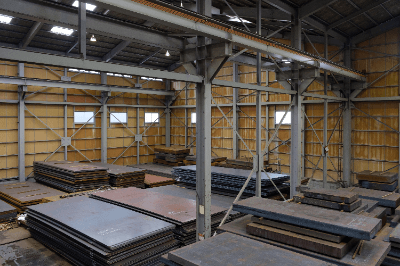What Is Steel?
 Steel is a general term for steel materials that are composed primarily of iron and used in all industrial fields.
Steel is a general term for steel materials that are composed primarily of iron and used in all industrial fields.
No steel material is composed of 100% iron, and chemical components such as carbon, nitrogen, and chromium are added to steel to give it strength, wear, and temperature resistance. The most common types of steel are SS (rolled steel for general structural purposes), SN (rolled steel for building construction), and SM (rolled steel for welded structures). SUS material (stainless steel), to which 10.5% or more of chromium is added to iron, is highly resistant to rust.
Uses of Steel
Steel is used in many familiar products, such as home appliances and automobiles. Steel materials have various requirements in terms of strength, temperature, conductivity, corrosion resistance, wear resistance, machinability, toughness, etc. Steel materials are manufactured to meet these requirements through processing methods, the ratio of chemical components added to the steel, and heat treatment.
When manufactured from steel stones by metal material manufacturers, they are formed into bar shapes such as H-shaped steel, I-shaped steel, and C-shaped steel, which are then sold as material shapes. These are used as building materials for bridges and other structures. In addition, tubular shapes are also available. Plate-shaped steel is also available for use as sheet metal for elevator walls and other thin sheets.
Properties of Steel
The chemical composition of steel is composed of the following five elements:
1. Carbon (C)
The addition of carbon will increase the strength of steel by increasing tensile strength and hardness. It also improves hardenability, but too much carbon can reduce toughness.
2. Silicon (Si)
Added as an oxygen absorber, Si can increase yield point and tensile strength without affecting toughness and elongation capacity. However, excessive additions can lead to brittle breakdown (embrittlement).
3. Manganese (Mn)
Manganese is added as a de-sulfurizing agent and improves hardenability, thereby increasing yield point and tensile strength without impairing toughness.
4. Phosphorus (P)
Phosphorus (P) is considered an impurity generated during steel refining, and is a substance that reduces strength, such as toughness and tensile strength. On the other hand, it has the effect of improving machinability, but basically, its content should be kept as low as possible.
5. Sulfur (S)
Like phosphorus, sulfur is treated as an impurity that reduces strength and weldability, so its content should generally be kept as low as possible. On the other hand, when combined with manganese, it acts as a chip breaker that moderately breaks up thread-like chips. Therefore, it may be added in appropriate amounts to improve machinability.
These five elements are collectively referred to as the five elements of steel, and since a significantly high content of any one element can adversely affect strength, the balance of content is adjusted according to the location and application where the steel is used to refine the steel to the right material for the right purpose. In addition, since the properties of steel also vary depending on how the steel is heat treated, adjustments must be made in consideration of the properties after heat treatment.
Types of Steel Materials
As representative examples of steel types, the following three types of steel have the following characteristics.
1. General Structural Rolled Steel (SS Material)
There are four types: SS330, SS400, SS490, and SS540. The numbers represent the lower limit of tensile strength. The chemical composition is determined by the amount of C, Mn, P, and S. SS400 is the most widely distributed and widely used.
2. Rolled Steel for Building Structure (SN Material)
There are five types of steel: SN400A, B, C and SN490B, C. SN400A, B, C and SN490B, C are used as structural materials for buildings and construction. It is intended to be used as a structural material for architecture and construction, and indexes for seismic resistance and weldability are determined. In order to ensure plastic deformation capacity, upper limits for yield ratio and yield point are specified.
3. Rolled Steel for Welded Structure (SM Material)
There are 11 types of SM materials, and the chemical composition of C, Si, Mn, P, and S is determined. SM materials are called Killed Steel (or Semi-Killed Steel) and are characterized by their lower oxygen content compared with SS materials.